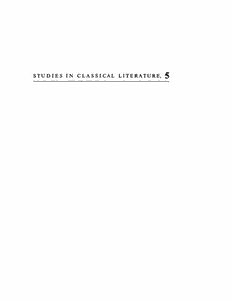
A commentary on Cicero's oration "De haruspicum responso" PDF
Preview A commentary on Cicero's oration "De haruspicum responso"
S T U D I ES IN C L A S S I C AL LITERATURE, 5 A COMMENTARY ON CICERO'S ORATION DE HARUSPICUM RES PON SO by JOHN O. LENAGHAN 1969 MOUTON THE HAGUE · PARIS © Copyright 1969 in The Netherlands. Mouton & Co. N.V., Publishers, The Hague. No part of this book may be translated or reproduced in any form, by print, photoprint, microfilm, or any other means, without written permission from the publishers. LIBRARY OF CONGRESS CATALOG CARD NUMBER: 68-17906 Printed in The Netherlands by Mouton & Co., Printers The Hague. TO MY WIFE PREFACE It is the principal purpose of this commentary to explain the historical allusions and background of Cicero's oration De Haruspi- cum Responso. It is my secondary purpose to date the oration. If, as I believe, it can be demonstrated that the oration was delivered in the first half of May 56, it gains considerably in importance. It would then provide an interesting example of Cicero's public views in the period immediately after the conference at Luca. The commentary is based upon the Oxford Classical Text of Peterson. The numbers before the individual lemmas represent the section number and the line number of Peterson's text. I have used the Oxford Classical Texts whenever possible; otherwise, I have used Teubner or Loeb texts with the standard section refer- ences. In cases which might prove confusing, however, I have indi- cated the editor. When I have done this, the numbers refer, not to the sections of the text, but to the pages of that particular edition (e.g. Ascon. 70 Clark).1 I have generally followed the abbreviations of the Oxford Classi- cal Dictionary. Where these seemed cumbersome or were non- existent, I have frequently adopted those used by Broughton in his Magistrates of the Roman Republic. When there is no indication of author in the citation of an ancient work, it is to be understood that the author is Cicero. When neither author nor work is speci- fied, the reference is to this oration. A reference to another part of the commentary will be given by the number of the section and 1 I have made an exception to this practice in my citation of Maurenbrecher's edition of Sallusts' Histories. 8 PREFACE the line of the lemma. Full citation of the lemma will be supplied only when necessary for clarity. Monographs of modern authors are cited only by the author's name; the full title may be found in the bibliography. When I have used more than one work of the same author or when there is a chance of confusion, I have indicated the work by an abbreviated title. A final note: numbers in paren- theses after a man's name are those under which he is found in Pauly-Wissowa. Unfortunately only after this commentary was in page proof have I seen Wuilleumier and Tupet's edition and translation in the Bude series. I have, nevertheless, as much as possible taken cognizance of their work, especially their succinct and excellent introduction. There is, however, one embarrassment. They have used, and generously acknowledged, my dissertation, which is an earlier version of this book. It is then not always easy to distinguish agreement from independent judgement. Accordingly I have decided that it would be unnecessary, and even pedantic, to give a specific citation, on each occasion on which we agree. I should like to acknowledge the following help and advice which I have received. My wife, Lydia, who had done work on De Haruspicum Responso for her master's thesis at Bryn Mawr College, has contributed much, especially in the introduction and the first part of the commentary. Professor Herbert Bloch of Harvard University has provided specific and detailed criticism, which has both helped and encouraged me. Professor Frank Bourne and Professor Emeritus Paul R. Coleman-Norton of Princeton University read the manuscript and suggested improve- ments, when it was submitted as a dissertation. Professor Herbert Rowen of Rutgers University has been especially kind in his general advice, which has helped to remedy some of the defects of in- experience. And I also wish to thank the Rutgers University Research Council for a subvention toward the cost of publication. CONTENTS Preface 7 I. Introduction 11 II. Dating 22 III. Publication and Delivery of the Speech 29 IV. The Haruspices 32 V. Authenticity 38 VI. The Manuscripts 42 VII. Commentary 46 Bibliography 199 Index 206
